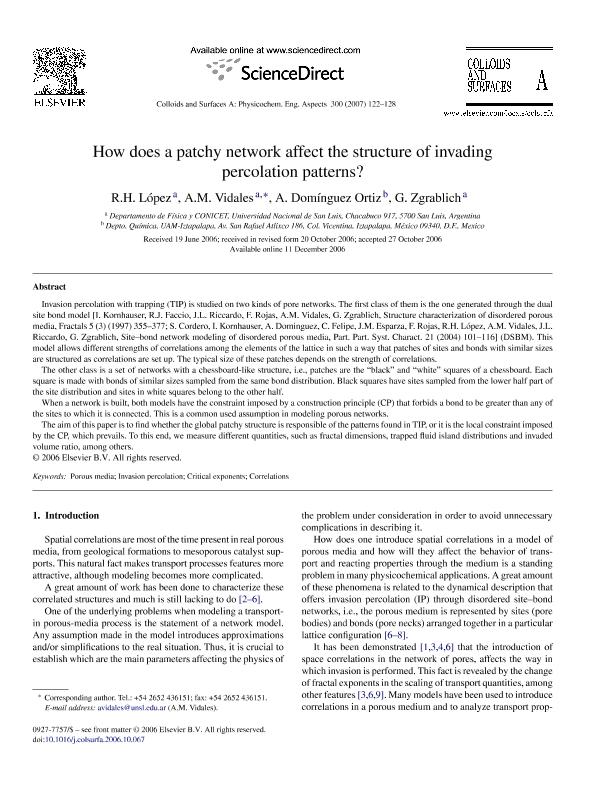Mostrar el registro sencillo del ítem
dc.contributor.author
López, Raúl Horacio

dc.contributor.author
Vidales, Ana Maria

dc.contributor.author
Domínguez Ortiz, A.
dc.contributor.author
Zgrablich, Jorge Andres

dc.date.available
2021-09-28T16:47:51Z
dc.date.issued
2007-06-01
dc.identifier.citation
López, Raúl Horacio; Vidales, Ana Maria; Domínguez Ortiz, A.; Zgrablich, Jorge Andres; How does a patchy network affect the structure of invading percolation patterns?; Elsevier Science; Colloids and Surfaces A: Physicochemical and Engineering Aspects; 300; 1-2 SPEC. ISS.; 1-6-2007; 122-128
dc.identifier.issn
0927-7757
dc.identifier.uri
http://hdl.handle.net/11336/141729
dc.description.abstract
Invasion percolation with trapping (TIP) is studied on two kinds of pore networks. The first class of them is the one generated through the dual site bond model [I. Kornhauser, R.J. Faccio, J.L. Riccardo, F. Rojas, A.M. Vidales, G. Zgrablich, Structure characterization of disordered porous media, Fractals 5 (3) (1997) 355–377; S. Cordero, I. Kornhauser, A. Dominguez, C. Felipe, J.M. Esparza, F. Rojas, R.H. Lopez, A.M. Vidales, J.L. ´ Riccardo, G. Zgrablich, Site–bond network modeling of disordered porous media, Part. Part. Syst. Charact. 21 (2004) 101–116] (DSBM). This model allows different strengths of correlations among the elements of the lattice in such a way that patches of sites and bonds with similar sizes are structured as correlations are set up. The typical size of these patches depends on the strength of correlations. The other class is a set of networks with a chessboard-like structure, i.e., patches are the “black” and “white” squares of a chessboard. Each square is made with bonds of similar sizes sampled from the same bond distribution. Black squares have sites sampled from the lower half part of the site distribution and sites in white squares belong to the other half. When a network is built, both models have the constraint imposed by a construction principle (CP) that forbids a bond to be greater than any of the sites to which it is connected. This is a common used assumption in modeling porous networks. The aim of this paper is to find whether the global patchy structure is responsible of the patterns found in TIP, or it is the local constraint imposed by the CP, which prevails. To this end, we measure different quantities, such as fractal dimensions, trapped fluid island distributions and invaded volume ratio, among others.
dc.format
application/pdf
dc.language.iso
eng
dc.publisher
Elsevier Science

dc.rights
info:eu-repo/semantics/openAccess
dc.rights.uri
https://creativecommons.org/licenses/by-nc-sa/2.5/ar/
dc.subject
CORRELATIONS
dc.subject
CRITICAL EXPONENTS
dc.subject
INVASION PERCOLATION
dc.subject
POROUS MEDIA
dc.subject.classification
Físico-Química, Ciencia de los Polímeros, Electroquímica

dc.subject.classification
Ciencias Químicas

dc.subject.classification
CIENCIAS NATURALES Y EXACTAS

dc.title
How does a patchy network affect the structure of invading percolation patterns?
dc.type
info:eu-repo/semantics/article
dc.type
info:ar-repo/semantics/artículo
dc.type
info:eu-repo/semantics/publishedVersion
dc.date.updated
2020-08-05T16:44:30Z
dc.identifier.eissn
1873-4359
dc.journal.volume
300
dc.journal.number
1-2 SPEC. ISS.
dc.journal.pagination
122-128
dc.journal.pais
Países Bajos

dc.journal.ciudad
Amsterdam
dc.description.fil
Fil: López, Raúl Horacio. Universidad Nacional de San Luis. Facultad de Ciencias Físico Matemáticas y Naturales. Departamento de Física; Argentina. Consejo Nacional de Investigaciones Científicas y Técnicas. Centro Científico Tecnológico Conicet - San Luis; Argentina
dc.description.fil
Fil: Vidales, Ana Maria. Universidad Nacional de San Luis. Facultad de Ciencias Físico Matemáticas y Naturales. Departamento de Física; Argentina. Consejo Nacional de Investigaciones Científicas y Técnicas. Centro Científico Tecnológico Conicet - San Luis; Argentina
dc.description.fil
Fil: Domínguez Ortiz, A.. Universidad Autónoma de Madrid; España
dc.description.fil
Fil: Zgrablich, Jorge Andres. Universidad Nacional de San Luis. Facultad de Ciencias Físico Matemáticas y Naturales. Departamento de Física; Argentina. Consejo Nacional de Investigaciones Científicas y Técnicas. Centro Científico Tecnológico Conicet - San Luis; Argentina
dc.journal.title
Colloids and Surfaces A: Physicochemical and Engineering Aspects

dc.relation.alternativeid
info:eu-repo/semantics/altIdentifier/url/https://www.sciencedirect.com/science/article/pii/S0927775706008351
dc.relation.alternativeid
info:eu-repo/semantics/altIdentifier/doi/http://dx.doi.org/10.1016/j.colsurfa.2006.10.067
Archivos asociados
